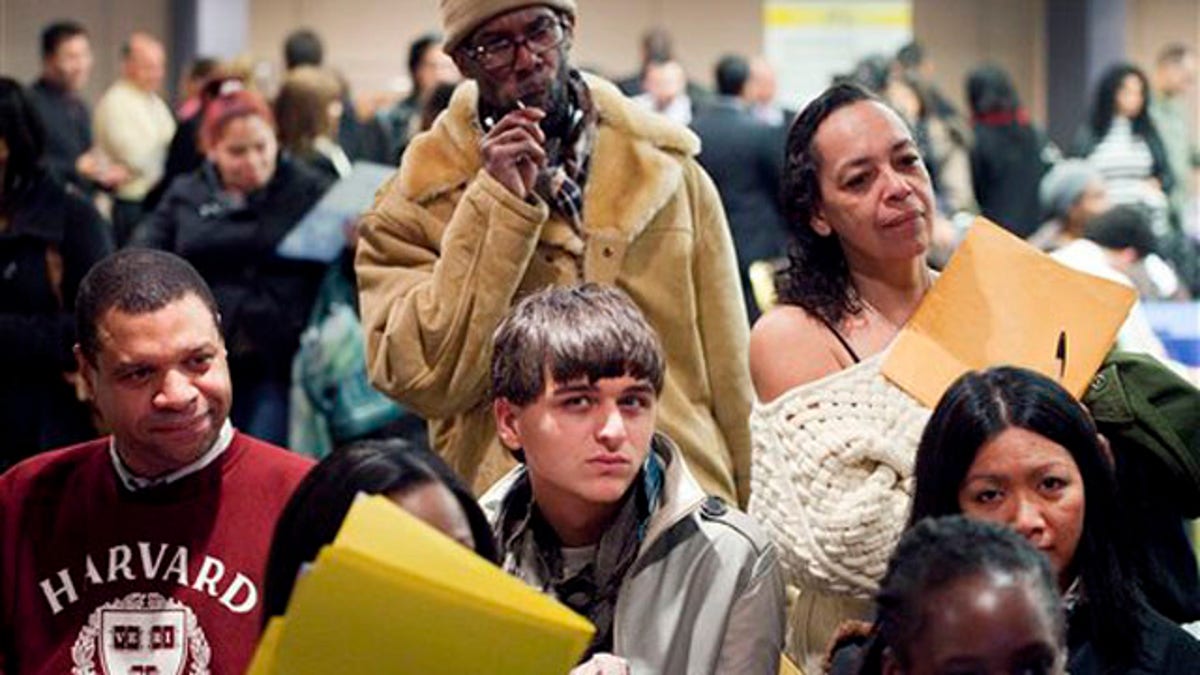
Feb. 22, 2012: Job seekers attend a National Career Fair in New York. (AP)
WASHINGTON – The unemployment rate remained unchanged at 8.3 percent last month, but the economy showed continued signs of growth as employers added 227,000 jobs across sectors ranging from manufacturing to health care.
The report, coupled with economic readings over the past three months, paint a picture of a modest -- albeit steady -- recovery. Recent job growth is among the strongest since the recession began. Yet the economy is still failing to catapult out of that recession. While the positive economic trend surely helps President Obama going into election season, the jobless rate itself remains dangerously high.
House Speaker John Boehner said in a statement that the February report provides "some encouragement" for the business community and families, "but unemployment remains far too high."
Boehner argued that the growth is occurring in spite of the administration, crediting American employers for creating jobs "in the midst of the onslaught of anti-business policies coming from this administration."
But the Obama administration on Friday touted new proposals meant to boost manufacturing, at a time when the labor report shows manufacturing jobs are on the rise.
"Today's employment report provides further evidence that the economy is continuing to heal from the worst economic downturn since the Great Depression," Alan Krueger, chairman of the Council of Economic Advisers, said in a statement. "It is critical that we continue the economic policies that are helping us dig our way out of the deep hole that was caused by the recession that began at the end of 2007, including measures to help the sectors that were most severely harmed by the bubble economy that misdirected investment and created too few durable jobs."
The unemployment rate in February was unchanged largely because more people streamed into the work force. That rate is still the lowest in three years.
And hiring in January and December was better than first thought. The government revised those figures to show 61,000 an additional jobs.
The economy has now generated an average of 245,000 jobs in the past three months. The only stretch better since the recession began was in early 2010.
Nearly a half-million people began looking for work last month, and most found jobs, the report said. That's a sign of growing optimism in the job market, as many people who had given up on looking for work come off the sidelines to search for jobs.
That also counters a troubling trend: a key reason why the unemployment rate has dropped since last year is that many out-of-work people have stopped looking for work. Only people without jobs who are actively seeking one are counted as unemployed.
Still, the number of long-term unemployed stood at 5.4 million, or about 43 percent of all unemployed. The percentage of Americans considered unemployed or underemployed was at 14.9 percent in February.
A sustained rise in the number of people looking for jobs would be a good sign, even if it pushed up the unemployment rate.
Friday's report comes as a host of data points to an improving economy and job market. Weekly applications for unemployment benefits have fallen about 14 percent in six months. Though they ticked up last week, average applications remain near a four-year low.
On Wednesday, payroll provider ADP said businesses added 216,000 employees last month, up from January's total. The ADP report doesn't include governments, which have been cutting jobs.
And service companies, which employ most Americans, are expanding at a faster pace, according to a private survey released this week. A gauge of employment shows that service firms are still hiring, particularly in the mining, educational services, and transportation and warehousing industries.
The service sector includes everything from restaurants and hotels to health care firms and financial service companies.
Some companies must hire because they can't squeeze more output from their current staffs. Last year, worker productivity rose at its slowest pace in nearly 25 years. That means companies will likely have to add staff to meet growing demand.
Other figures point to the same conclusion. The average work week was unchanged at 34.5 hours. That's close to the pre-recession total and suggests that companies will have to hire more workers as business improves, rather than adding more hours.
The Associated Press contributed to this report.












































